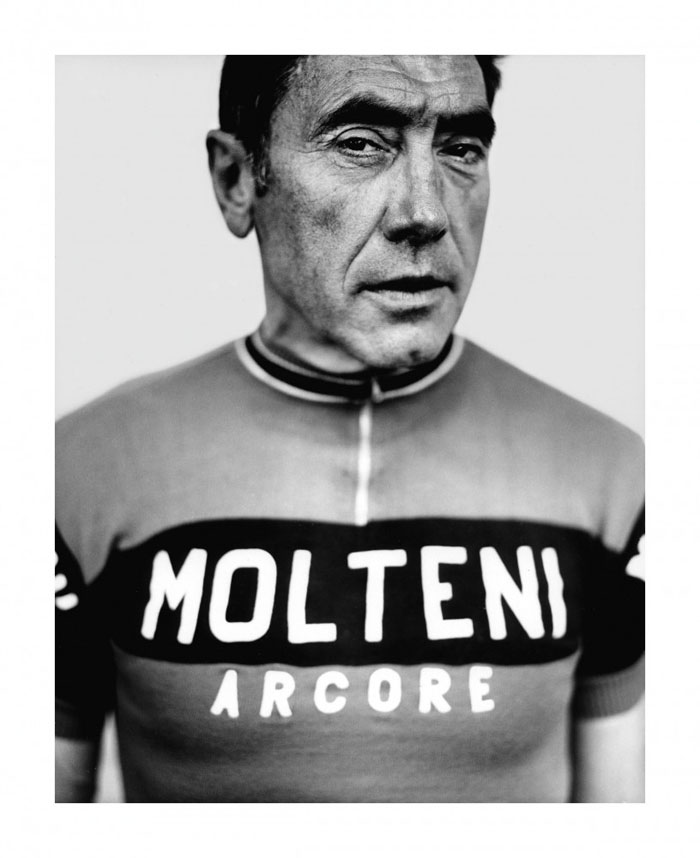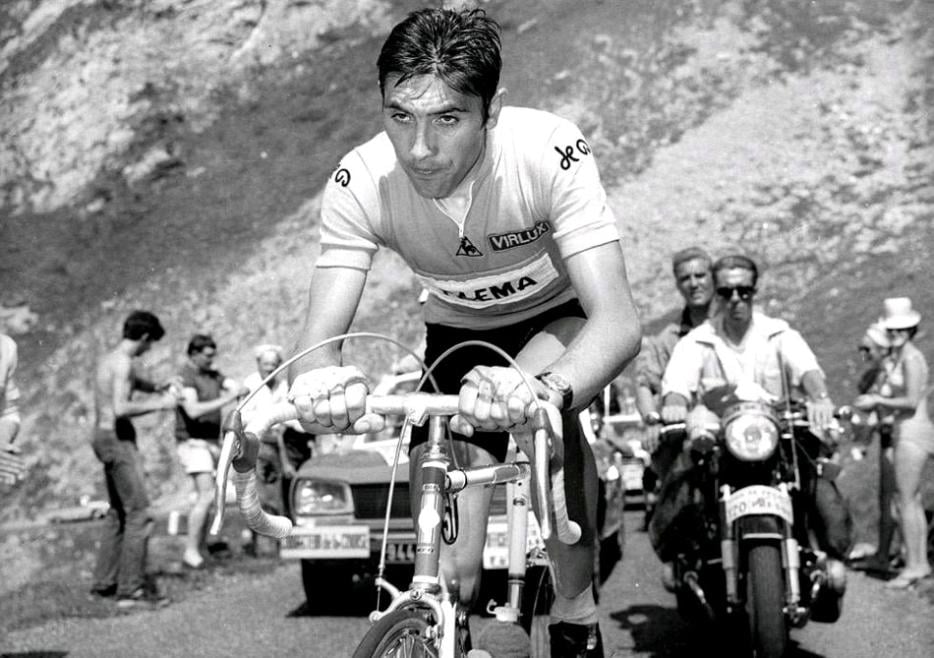Who rides?
Answer: Cannibals. People who eat people. Conversely: cannibals’ victims, those eaten by people who eat people. For now, we must concentrate on asking why cycling, unique among sports, is made up of flesh eaters/dinner ingredients. Wayne Gretzky was called “The Great One.” Michael Jordan was “Air Jordan.” Eddy Merckx, cycling’s leading eminence?
“The Cannibal.”
Cycling has always made mincemeat of men. At its inception, it was a working-class sport, indistinguishable from the farm or the factory in a rapidly industrializing Europe. Who rode? The poor, the unlucky, the daft, the ecstatically religious. Forçats de la route, “forced labourers of the road,” insisted the Socialist firebrands who picketed in support of these maligned characters. The leftists didn’t see sportsmen but rather ouvriers de la pédale, “pedal workers.”
Cyclists understood themselves in a similar light. Wrote the Italian author Dino Buzzati, upon his retirement, “And without a number and jersey we, too, will sit on our doorstep, on these days in May and June, to watch other legs turning; no longer ours, though. And we will say: For us (thank heavens!), no more backbreaking exertion, dust, torment, oh, oh, and no more dysentery. We’ve had enough of that hellish life of a convict!”
The inaugural Tour de France, held in 1903, had a direct precursor in an automobile race called Paris–Madrid, which devolved from modernist panegyric to carnage in a matter of hours. People, livestock, dogs, all killed by the “folly of speed.” The race was never repeated.
One month later, the Tour de France tore through the country with less gore and significantly more pageantry. Henri Desgrange, the editor-in-chief of the periodical L’Auto (and the Tour’s founding director), promised that the contest would send “those tough, uncomplicated sowers of strength, the great professional roadsters,” into the common Frenchman’s imagination—more than that, past his front door. The peasant would never forget the cycling hero, contended Desgrange, “Because he will have seen him.” Desgrange had invented the Grand Tour: there were no motor paces, the race was split into stages, and the fastest time overall, or the “general classification,” earned the yellow jersey. The winner of the first race, Maurice Garin, was known as “the Little Chimney-Sweep”—when he was an infant, his father traded him for a wheel of cheese. He raced against Pothier the little butcher’s boy, Dargassies the blacksmith, and Brange the barkeep. A coterie of working men, with soot-blackened fingers and hard peasant eyes. They set up shop in the French pantheon and refused to budge.
Cycling has always made mincemeat of men. At its inception, it was a working-class sport, indistinguishable from the farm or the factory in a rapidly industrializing Europe. Who rode? The poor, the unlucky, the daft, the ecstatically religious.
The author and humorist Judith Newman describes sportswriters as “fellows who don’t just document the mildew and peeling paint on a boxing gym’s walls but go on to liken it to the weeping of fetid tears over the tragedies they’ve seen” (which, come to think of it, reasonably sums up the conceit of this essay). In cycling’s case, Ms. Newman is doubly correct, because Desgrange designed cycling to be written about in this way. An Italian journalist covering the 1949 Giro d’Italia portrayed Fausto Coppi as Achilles and his foe, Gino Bartali, as Hector. Roland Barthes, in a chapter in Mythologies entitled “The Tour de France as Epic,” states that the Tour is a “unique fable” that “liberates French people.” Grand Tours are described as “Homeric”; certainly, they are an “odyssey.” A solo break is “Sisyphean.” As Hugh Dauncey and Geoff Hare, two of the Tour de France’s chroniclers, have pointed out, the race is “the non-religious equivalent of the medieval mystery play, defining (and redefining) the nature of masculinity, glory and heroism. It is at once both a secular and sacred experience.”
Maybe. But Grand Tours, and cycle races in general, were from birth craven, commercial enterprises, engineered to sell the bourgeoisie on modernity’s latest tricks. The sport has always been about money. It’s always been tied to newspaper sales (in the Tour’s case, first L’Auto and now L’Équipe, whose circulation rises by a third during the race). From its first moment, racing required sponsors. Sponsors demanded results. Results were acquired through both ability and deception: during the 1904 Tour de France, the roads were lined with highwaymen, drive-by shooters, enraged gamblers, drunken mass murderers and loose women—sleaze was rampant, cheating was de rigueur. It took the Super Bowl almost thirty years before Janet Jackson experienced a wardrobe malfunction; it took the Tour de France all of eleven months before the first breasts were bared.
Duelling tropes were established. Cyclists were either gods or bumpkins caught in the pincer grip of exploitation and corruption. It does seem almost too perfect that cycling’s Grand Mufti, its Abraham, its Luke Skywalker, is the Belgian Eddy Merckx, son of a grocer, and a labourer of the road. “We were not rich,” Merckx has said of his family. “We did not go to the Côte d’Azur or skiing. Our only vacation was to the North Sea. I had to pay for my bicycle every month, but we always had food.”

Merckx acquired his nickname from his 12-year-old daughter. “Daddy, he’s a cannibal,” she warned a member of Merckx’s Peugeot squad. The Cannibal, who dominated from the mid-’60s to the mid-’70s, is certainly the best cyclist of all time. But there are only minor and easily dismissed arguments to be made against this claim, according him the status of Greatest Athlete of the Modern Era—in any sport, and by a long shot. Eddy was Michael Jordan if Jordan had Shaq’s size; Wayne Gretzky if he was also Paul Coffey and Marty McSorley; John Elway if Elway was also the entire Broncos defensive line. He rode track, won the Classics and won all three major Grand Tours. He did so even though the (largely French) cycling establishment was against a Belgian picking off Tour de France victories. He was punched in the liver by a spectator during the ‘75 Tour and forced to abandon his attempt at a sixth title.
Eddy Merckx is the Ur-cyclist, and thus the Ur-athlete. But who is he? I met him once at a trade show, we shook hands, he was gone in an instant. I tried to get a whiff of his limitless power—I literally tried to smell him, to huff in his pheromones, to see if I could unlock his mystery via his scent. I have watched almost every second of Merckx committed to film, and there was no sense of the athlete in the man, no hint in how he carried himself of who he once was. To meet Kobe Bryant or Cristiano Ronaldo is to meet athletes who absorb adulation, who glow from it. They take off their sunglasses and you think, nice move. Merckx looked like an aging banker, and the love just bounced off him and fizzled into dead energy at his feet.
I do sometimes wonder, though, whether Armstrong was bummed that “the Cannibal” had been snapped up as a sobriquet before he made the scene. No one ate people like Armstrong. He ate not just his opponents but the men on his teams. Churned through them. He made many careers, a huge caste of cronies. When he was done with them, they were put on the menu.
He is a terrible interview who has never been profiled satisfactorily, mostly because he keeps himself tightly buttoned. One will get more answers interviewing Eddy’s bicycle. He has much to hide—he is no doubt reluctant to talk about poppers and speed and other, earlier, tools of the trade, some for which he was disqualified. “Products that made you a little less tired,” as Merckx has described them. A distinction, he insists, from products that “make you better.”
Merckx rode with his head off to the side like a trotting hound, and always looked like he was losing, even when the rest of the field was eight miles back. He is a big man, too well built for cycling. He had no souplesse—suppleness, the ideal of riding with élan, of making hell look effortless. Souplesse is not a technique, it is an attitude. (Armstrong’s lack of it partly explains the early French revulsion toward him.) If you want an example of souplesse, or of the noble officer class that it is meant to emulate, watch Pierre Fresnay’s performance as Captain de Boeldieu in Jean Renoir’s Grand Illusion. He never broke a sweat, never looked concerned, and died like a gentleman.
Cycling imposed aristocratic mores on working-class boys, which is not to say that every cyclist was working class—five-time Tour winner Jacques Anquetil rode with souplesse because he was born a Sun King. Merckx, however, ate people. You can see it in old race footage: he devoured them. I don’t want to overstate my own race credentials, but once or twice, I’ve done the same thing, felt the man beside me break, felt as if I’d stripped the flesh from his bones. I suspect that the feeling has its roots in ancient battle rituals—nothing says victory better than ripping out and consuming the warm heart of an enemy.
The impulse in any sport is not only to beat those alongside you on the start line but to erase the records of previous generations. When Armstrong was dying of cancer in a Texas hospital, the Cannibal paid a visit. They’ve always admired each other, despite their manifold dissimilarities. I do sometimes wonder, though, whether Armstrong was bummed that “the Cannibal” had been snapped up as a sobriquet before he made the scene. No one ate people like Armstrong. He ate not just his opponents but the men on his teams. Churned through them. He made many careers, be they fellow cyclists, doctors, sunglass manufacturers, writers, lawyers, masseuses. A huge caste of cronies. When he was done with them, they were put on the menu. From 1998 to 2011, Armstrong fed and fed—the most significant gorging sports has ever known. By the time he was done, there was almost nothing left of the sport that made him, of the sport that Desgrange made, of the sport that Armstrong’s voraciousness helped turned supernova.
--
Excerpted from the Hazlitt Original, Braking Bad: Chasing Lance Armstrong and the Cancer of Corruption.






